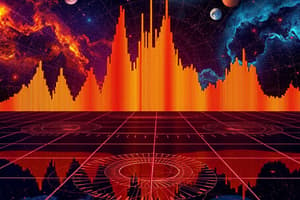Podcast
Questions and Answers
What classic mathematical tool is used to decompose signals into sinusoids?
What classic mathematical tool is used to decompose signals into sinusoids?
- Wavelet transform
- Z-transform
- Fourier transform (correct)
- Laplace transform
Which characteristic of sinusoids measures the signal's strength or presence?
Which characteristic of sinusoids measures the signal's strength or presence?
- Period
- Frequency
- Phase
- Amplitude (correct)
What effect does windowing have on the Fourier transform output?
What effect does windowing have on the Fourier transform output?
- It introduces a scaling factor.
- It simplifies the signal representation.
- It causes convolution with the window function Fourier transform. (correct)
- It narrows the frequency range.
How is frequency determined in Fourier transform analysis?
How is frequency determined in Fourier transform analysis?
What kind of function is used to extend a finite-duration signal in Fourier transform computations?
What kind of function is used to extend a finite-duration signal in Fourier transform computations?
Which result occurs in the frequency domain when a rectangular window is applied?
Which result occurs in the frequency domain when a rectangular window is applied?
What does the integration process achieve when computing the Fourier transform?
What does the integration process achieve when computing the Fourier transform?
What type of analysis does the Fourier transform primarily provide for time-domain signals?
What type of analysis does the Fourier transform primarily provide for time-domain signals?
Flashcards
Fourier Transform
Fourier Transform
A mathematical tool that breaks down signals into their basic sinusoidal components.
Sinusoids
Sinusoids
Waves characterized by their amplitude, frequency, and phase.
Amplitude
Amplitude
The strength or intensity of a signal.
Frequency
Frequency
Signup and view all the flashcards
Phase
Phase
Signup and view all the flashcards
Spectral Analysis
Spectral Analysis
Signup and view all the flashcards
Window Function
Window Function
Signup and view all the flashcards
Convolution
Convolution
Signup and view all the flashcards
Study Notes
Fourier Transforms and Spectral Analysis
- Fourier transform decomposes signals into fundamental building blocks, which are sinusoids.
- Sinusoids are characterized by amplitude, frequency, and phase.
- Amplitude represents the signal's strength or presence.
- Frequency measures the signal's rate of repetition.
- Phase determines the signal's time shift.
- Fourier transforms analyze time domain signals by transforming them into the frequency domain.
- Frequency domain representation provides information about the signal's amplitude, phase, and frequency content.
- Complex exponentials are used in Fourier transforms and can be represented as rotating vectors with real and imaginary components.
- Fourier transform computation involves multiplying the time domain signal by a complex exponential, and then integrating from minus infinity to infinity.
- The spin frequency of the complex exponential is used to determine the signal's frequency components.
- When the spin frequency matches a signal frequency, the graph's center shifts away from the time axis, indicating the presence of that frequency.
- Integration is used to quantify the graph's shift and identify frequency components.
- Window functions, like the rectangular window, are used to artificially extend the signal to infinity, enabling the use of Fourier transforms for finite-duration signals.
- Windowing introduces a side effect, as the Fourier transform of the original signal becomes convolved with the Fourier transform of the window function.
- The convolution of two functions in the time domain corresponds to the multiplication of their respective Fourier transforms in the frequency domain.
- Rectangular window results in a sinc function in the frequency domain, impacting the Fourier transform output by creating peaks at the signal frequencies.
- Fourier transforms are crucial for digital signal processing applications, enabling the analysis of signals in the frequency domain and providing valuable insights into their spectral content.
Studying That Suits You
Use AI to generate personalized quizzes and flashcards to suit your learning preferences.




